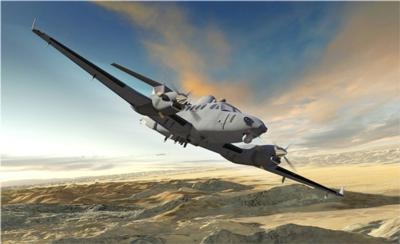Initial Low-Rate Production Expected To Begin Next Fiscal Year
Army scientists, engineers and program developers are making substantial progress building and integrating a technically sophisticated battlefield surveillance aircraft called Enhanced Medium Altitude Reconnaissance and Surveillance System in a laboratory at Aberdeen Proving Ground, MD, service officials said.

The initial task, now underway at Aberdeen's Joint Test and Integration Facility, is aimed at engineering and integrating an Enhanced Medium Altitude Reconnaissance and Surveillance System, or EMARSS, fuselage with cameras, sensors, software, antennas, intelligence databases and electronic equipment so that the Army can deliver four Engineering Manufacturing Development aircraft to Afghanistan as part of a forward assessment of the capabilities, said Raymond Santiago, deputy product manager, Medium Altitude Reconnaissance and Surveillance Systems.
"An EMARSS Forward Operational Assessment will place this system in the hands of our Soldiers, allowing them to inform an assessment as to whether the system meets the approved requirements. We will get to see the system being used to gather real-world data in a combat environment, with a high optempo. This will help us refine and establish the architecture for the platform," an Army acquisition official explained.
The Army plans to complete the EMARSS EMD Phase with a minimum of four aircraft systems. Overall, the EMD contract has options to procure two additional EMD systems and 4-6 Low Rate Initial Production systems. Plans for the EMARSS aircraft include efforts to engineer a surveillance aircraft with a wide range of vital combat-relevant capabilities, such as the ability to quickly gather, integrate and disseminate intelligence information of great value to warfighters in real time; it is being built to do this with an integrated suite of cameras, sensors, communications and signals intelligence-gathering technologies and a data-link with ground-based intelligence databases allowing it to organize and communicate information of great relevance to a commander's area of responsibility, Santiago explained.
The work at the JTIF laboratory, involving a significant development and integration-related collaborative effort with Army and industry engineers, is aimed at reducing risk through rapid prototyping and software and sensor integration. The EMARSS fuselage in the laboratory is a built-to specification model of a Hawker Beechcraft King Air 350, Santiago said. "The laboratory gives us the flexibility to try things out with the fuselage. This helps us with how we configure the equipment," Santiago added.
A key aim of the effort is to engineer and configure a modular aircraft designed with "open architecture" and a plug-and-play capability, allowing it to successfully integrate and function effectively with a variety of different sensor payloads, software packages and electronic equipment, he said. "We want to build one bird with as many common capability packages on it as well as a full-motion video camera. We want it to be sensor agnostic," Santiago said.
For example, the EMARSS aircraft is being configured to integrate a range of sensor packages such as Electro-Optical/Infrared cameras, MX-15 full-motion video cameras and an imaging sensor technology known as Wide Area Surveillance System able to identify and produce images spanning over a given area of terrain, Army acquisition officials explained.
The EMARSS capability is unique in that it is engineered with a data-link connecting the aircraft to the Army's ground-based intelligence database called Distributed Common Ground System - Army. DCGS-A is a comprehensive integrated intelligence data repository, able to compile, organize, display and distribute information from more than 500 data sources; DCGS-A incorporates data from a wide array of sensors, including space-based sensors, geospatial information and signal and human intelligence sources. By having a data-link with information from the ground-bases DCGS-A, flight crews on board EMARSS will be able to use display screens and on-board electronics to receive and view intelligence information in real-time pertaining to their area of operations. Also, EMARSS' plug-and-play, open architecture framework is being engineered so that the aircraft could potentially accommodate certain radar imaging technologies in the future, such as Ground Moving Target Indicator, a radar imaging technology able to
detect moving vehicles and Synthetic Aperture Radar, a radar system able to paint an image or picture of the ground showing terrain, elevation and nearby structures, Santiago said.
Given that all the sensors, antennas, cameras and electronics are designed to operate within a common architecture, one possibility is to strategically disperse various sensor capabilities across a fleet of several EMARSS aircraft, thus maximizing the ability to gather and distribute relevant intelligence information, Santiago explained.
The Army Training and Doctrine Capability Manager for Intelligence Sensors (TCM Intel Sensors) is also working on the Capabilities Production Document which, according to plans, will eventually be submitted to the Joint Requirements Oversight Council before the EMARSS program can achieve a Milestone C production decision paving the way for limited rate initial production of the system in FY 13, Army acquisition officials explained.
(Image provided by the U.S. Army)
 ANN's Daily Aero-Linx (04.15.24)
ANN's Daily Aero-Linx (04.15.24) Classic Aero-TV: 'No Other Options' -- The Israeli Air Force's Danny Shapira
Classic Aero-TV: 'No Other Options' -- The Israeli Air Force's Danny Shapira Aero-News: Quote of the Day (04.15.24)
Aero-News: Quote of the Day (04.15.24) Airborne 04.16.24: RV Update, Affordable Flying Expo, Diamond Lil
Airborne 04.16.24: RV Update, Affordable Flying Expo, Diamond Lil ANN's Daily Aero-Term (04.16.24): Chart Supplement US
ANN's Daily Aero-Term (04.16.24): Chart Supplement US



